Key:maxweight
 |
| Description |
|---|
| Permissible maximum actual weight in metric tonnes (or other explicitly specified unit). |
| Group: restrictions |
| Used on these elements |
| Useful combination |
|
| See also |
| Status: de facto |
| Tools for this tag |
|
Legal access restriction for vehicles or passengers that exceed the specified actual weight, especially useful on bridge segments (tagged with bridge=*). Metric tonnes are a default unit, other units must be explicitly tagged. Typical usage is to add this tag to highway=* lines where maxweight limit applies.
- For maximum gross weight see
maxweightrating=*.
Difference from maxweightrating=*
Depending on the country, maximum weight restrictions on public roads can take different forms. The maxweight=* tag is for the case where the restriction is applied to the actual weight of the vehicle (and its load) at the time it uses the road. However, it is also common for weight restrictions to be placed on the the size of vehicles according to the maximum weight they are authorized/registered for. This is often known as the maximum registered weight or maximum gross weight. For restrictions of this latter type, the maxweightrating=* key should be used instead. Often these maximum registered weight restrictions only apply to certain types of vehicles (e.g. good vehicles) and are designed to restrict larger vehicles rather than to apply a weight limit for safety reasons. In this case, maxweightrating:goods=* or maxweightrating:hgv=* (or whatever mode is specified) should be used instead.
Sometimes the signs for maxweightrating=* will be distinguished from those for maxweight=* by the presence of a "m.g.w." abbreviation or similar. But sometimes signs with just a weight and an image of a lorry correspond to maxweightrating=*. It is necessary to understand the meaning of the signs in a given country in order to determine which key should be used in OSM.
| Sign | Tag | Meaning |
|---|---|---|
maxweight=5.5 |
Vehicles that currently weigh above 5.5 t are prohibited on this road. | |
maxweightrating:hgv=5.5 |
Lorries that are legally permitted to weigh (i.e., at full load) more than 5.5 t are prohibited on this road. |
So the latter sign is a more precise way for the road traffic authority to say that access for "big lorries" is prohibited and has nothing to do with the vehicle's current actual weight. A similar mechanism is the "Unladen mass" (Chap. 1, Art. 1 (x) Vienna Convention on Road Traffic); e.g., in the United States the "empty weight" restriction, for which maxunladenweight=* has been proposed.
For example, an empty truck that weighs 5 t and can carry 10 t has
- current weight of 5 t
- max permitted weight of 15 t
It means that it may pass through a road signed with maxweight=10 but not through one signed with maxweightrating=10
Vehicle weight
A number of navigable structures that are mapped as ways or areas may be tagged with a vehicle weight restriction, such as:
If a unit is not specified, the value is assumed to be in tonnes (British English, 'metric tons' in American English). You must explicitly specify the unit if it is not in metric tonnes. See page Units for possible units and format. If the restriction applies only to some classes of vehicles, way direction, lanes, or time condition, follow maxspeed#Extended tagging.
In cases of some objects, for example bridges it may be desirable to tag that place was surveyed and no max weight sign was found. Tag used for this include maxweight=unsigned and maxweight:signed=no. There is also maxweight=none, but it is misleading as there are also default max weight of vehicles set by law, it is unlikely to find place where one is actually allowed to drive vehicles without any weight limits. However, it is the value used with maxweight:conditional=none @ * so should be treated as meaning defaults apply.
Basic example

A small bridge with limited weight
Tags on a road segment representing road on a bridge:
Regional variations
Vienna Convention
In the Vienna Convention on Road Traffic (Nov 8, 1968), this property relates to Chapter 1, Art. 1 (y) Laden mass means the actual mass of the vehicle as loaded, with the crew and passengers on board;
France
France, despite being a member to the Vienna Convention on Road Traffic, defines the number sign to indicate gross weight rating and not the actual weight.
United States
In most of the United States, weight restrictions are expressed in short tons (abbreviated as "tons", "T", or "t"), which should be tagged as maxweight=### st, and sometimes in pounds (abbreviated as "lbs"), which should be tagged as maxweight=### lbs, but never as metric tons. In Texas, the weight given on signs is always expressed in pounds; likewise in Mississippi, where most weights in pounds do not divide evenly into tons. [2] (In the past, many mappers converted short tons to pounds and used the lbs suffix even when the signs were expressed in short tons. More recently, the st suffix was introduced for short tons, so that mappers don't have to do arithmetic.[1])
Besides the prima facie restrictions on the signs below, each state has a number of statutory tolerances and exemptions for specific types of cargo, often seasonally.[2] Mappers should focus on the restrictions on the signs and ignore statutory exceptions.
New Zealand
Bridge weight restrictions in New Zealand are usually expressed either as a percentage of Class 1 (or Class I) standard or General Access standard, as prescribed in the Vehicle Dimensions and Mass rules (this is distinct from the Class 1 "car" driver licence weight limit of 6 tonnes.) As the percentage signs require a bit of knowledge of the VDAM rules and some arithmetic, they are slowly being phased out with signage showing the maximum weight based on the number of axles.
The Class 1 standard is as follows:
- 2 axles = 15.5 tonnes
- 3 axles = 22 tonnes
- 4 axles = 26 tonnes
- 5 axles = 32 tonnes
- 6 axles = 36 tonnes
- 7 axles = 40 tonnes
- 8 or more axles = 44 tonnes
Examples by sign
with signs around the world:
-
Argentina:
maxweight=4 -
Armenia:
maxweight=7 -
Australia:
maxweight=* -
Brazil:
maxweight=10 -
Finland:
maxweight=12 -
Georgia:
maxweight=7 -
Guernsey:
maxweight=30 cwt -
Greece:
maxweight=5 -
Hong Kong:
maxweight=10 -
Ireland:
maxweight=10 -
Israel:
maxweight=6 -
Mexico:
maxweight=10 -
New Zealand:
maxaxleload=4.6maxweight=9.2maxweight:conditional=9.2 @ (axles=2); 13.8 @ (axles=3); 18.2 @ (axles=4); 22.4 @ (axles=5); 25.2 @ (axles=6); 28 @ (axles=7); 30.8 @ (axles>=8)[3]maxspeed:hgv=50 -
Philippines:
maxweight:hgv=17maxweight:hgv:conditional=17 @ (axles=2); 27 @ (axles>=3); 38 @ (axles>=5) -
Saudi Arabia:
maxweight=* -
Singapore:
maxweight=26 -
South Korea:
maxweight=5.5 -
Taiwan:
maxweight=5.5 -
Thailand:
maxweight=10
Canada
United States
Federal, state, county, and municipal highway departments post a wide variety of sign designs that indicate a number of different formulae for computing weight restrictions. The most common sign designs are displayed in the following gallery, most of them from state standards.
-
United States:
maxweight=8 st[4]maxweight:hgv_articulated=12 stmaxweight:hgv:conditional=16 st @ (trailer)
(specify unit as short tons) -
United States:
maxweight=12 stmaxweight:hgv:conditional=12 st @ (axles=2); 12 st @ (axles=3); 15 st @ (axles=4); 15 st @ (axles=5); 18 st @ (axles>=6); 24 st @ (trailer)maxweight:hgv_articulated=20 st
(specify unit as short tons) -
United States:
maxaxleload:emergency=12 stmaxbogieweight:emergency=26 stmaxweight:emergency=43 st
(specify unit as short tons) -
California:
-
Delaware/Maryland:
maxweight=3 stmaxweight:hgv:conditional=20 st @ (axles=3); 28 st @ (trailer)maxweight:hgv_articulated=27 st -
Illinois:
maxweight=17 stmaxweight:hgv:conditional=21 st @ (axle=3 and trailer); 21 st @ (axle=4 and trailer); 23 st @ (axle>=5 and trailer)maxweight:hgv:conditional=21 st @ (axle=3 or axle=4); 23 st @ (axle>=5)
(specify unit as short tons) -
Illinois:
maxweight:hgv=22 stmaxweight:hgv:conditional=29 st @ (axle=3 and trailer); 29 st @ (axle=4 and trailer); 36 st @ (axle>=5 and trailer)maxweight:hgv_articulated:conditional=29 st @ (axle=3 or axle=4); 36 st @ (axle>=5)
(specify unit as short tons) -
Illinois:
maxweight:hgv=16 stmaxweight:hgv:conditional=20 st @ (trailer)maxweight:hgv_articulated=20 st
(specify unit as short tons) -
Kentucky:
-
Michigan:
-
New Jersey:
-
Ohio:
-
Oregon:
maxweight=25 stmaxweight:hgv_articulated=40 stmaxweight:hgv:conditional=27 st @ (axles=4); 31 st @ (axles=5); 36 st @ (axles>=6); 40 st @ (trailer)
(specify unit as short tons) -
Puerto Rico:
-
Tennessee:
-
Texas:
maxweight=25100 lbsmaxweight:hgv:conditional=38200 lbs @ (trailer)maxweight:hgv_articulated=38200 lbsmaxaxleload=10400 lbsmaxbogieweight=16200 lbs
(specify unit as pounds)
Lookalikes
Caution, pitfall! The signs below are not weight restrictions, but rather restrictions for goods vehicles with a maximum allowed weight above the depicted value, or max weight per axle not per vehicle.
See more examples at Key:maxweightrating and Key:maxaxleload pages.
-
Germany:
maxweightrating:hgv=7.5 -
Ireland:
overtaking:hgv:conditional=no @ (weight>3) -
Ireland:
maxweightrating:hgv=3.5 -
Singapore:
maxunladenweight=2500 kg -
United Kingdom:
maxweightrating:hgv=7.5 -
United State, Ohio:
maxaxleload:emergency=12 stmaxbogieweight:emergency=26 st
(specify unit as short tons) -
United States, Texas:
maxbogieweight=28000 lbs
Passenger weight
This key is also used to indicate a maximum passenger weight on some conveyances that may be mapped as nodes, ways, or areas, such as:
These restrictions are usually expressed in human-scale units, such as kilograms (kg) and pounds (lbs). You must explicitly specify the unit to prevent data consumers from misinterpreting a passenger weight restriction as a tonnage.
References
- ↑ https://osmus.slack.com/archives/C029HV951/p1561048586262200
- ↑ “Compilation of Existing State Truck Size and Weight Limit Laws”. Federal Highway Administration. February 1, 2017. Retrieved July 6, 2019.
- ↑ Each Class I weight for an axle configuration is multiplied by 0.7. For 2-axle and 3-axle vehicles, the maximum axle load (4600 kg) limits the gross weight further below 70% of Class I.
- ↑ Per section 2B.64 of the MUTCD: "The symbols shown on the R12-5 and R12-6 Weight Limit sign [


 ] shall apply to all trucks of that configuration (single-unit, single-trailer or multi-trailer) regardless of the shape of the vehicle." [1]
] shall apply to all trucks of that configuration (single-unit, single-trailer or multi-trailer) regardless of the shape of the vehicle." [1]
- ↑ proposed on tagging mailing list https://lists.openstreetmap.org/pipermail/tagging/2019-July/046374.html as
maxemptyweight=*, later changed proposed key for reasons listed in https://lists.openstreetmap.org/pipermail/tagging/2019-July/046477.html
See also
maxweightrating=*- for restrictions that are not based on the actual weight but on the gross maximal mass rating of the vehicle. (Legal access restriction for vehicles with a maximum permitted mass above the specified mass in metric tonnes).maxunladenweight=*- for restrictions based on the unladen or empty weight of a vehicle.maxaxleload=*- The legal maximum axleload in metric tonnes.access=*- legal accessibility according to vehicle class or kind of useamenity=weighbridge- A large weight scale to weigh vehicles and goods- Conditional restrictions - restrictions depending on a condition.
- Proposed_features/gross_weight - Proposal to express limitations/restrictions of the acutal weight, weight rating of vehicles and combinations (trailers) and to express conditional restrictions based on weight properties
- Relation:enforcement +
enforcement=maxweight- permanently installed devices that measure and document traffic violations, such as maxweight
External links
- "Vehicle Types", Traffic Monitoring Guide, U.S. Federal Highway Administration Office of Highway Policy Information – helpful for interpreting truck symbols on U.S. signs

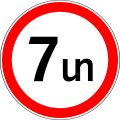




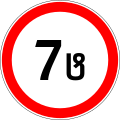






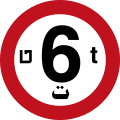




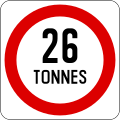


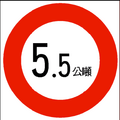
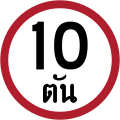









![United States: maxweight=8 st[4] maxweight:hgv_articulated=12 st maxweight:hgv:conditional=16 st @ (trailer) (specify unit as short tons)](https://upload.wikimedia.org/wikipedia/commons/thumb/2/28/MUTCD_R12-5.svg/80px-MUTCD_R12-5.svg.png)

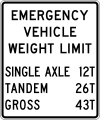



















![United States: maxunladenweight:hgv=7000 lbs[5]](https://upload.wikimedia.org/wikipedia/commons/thumb/2/23/MUTCD_R12-3.svg/80px-MUTCD_R12-3.svg.png)




